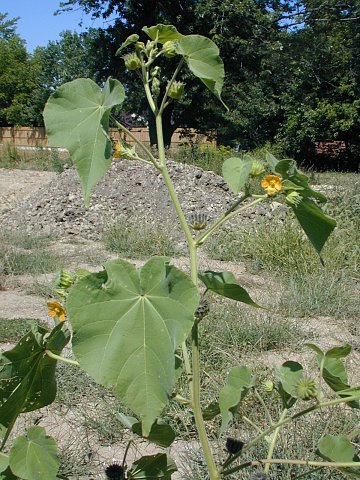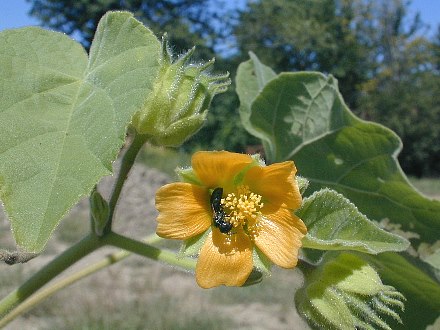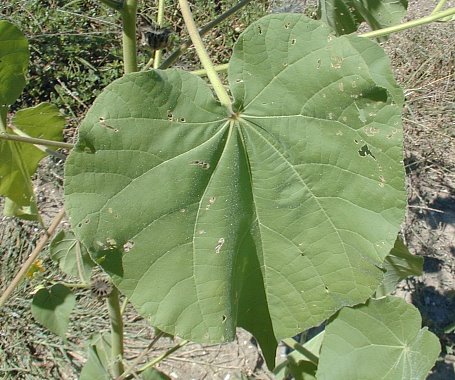Description: This plant is a summer annual about 2-7' tall that branches occasionally. The stems are terete (circular in cross-section), and pubescent. The alternate leaves are up to 8" long and across (excluding the petioles). They are cordate or orbicular-cordate, slightly dentate along their margins, and more or less pubescent. The primary veins of the leaves are arranged palmately. The petioles are up to 4" long and pubescent as well. The foliage of the entire plant is mostly light green, although the upper surfaces of the leaves are dull green.

From the axils of
the upper leaves, there occasionally develops a single flower about ¾"
across. It consists of 5 petals that are orange-yellow or yellow, 5
sepals that are pubescent and light green, and numerous stamens with
golden yellow anthers that surround the pistil in a loose cluster. The
flowering stalk of each flower is about 1" long, which is much shorter
than the petioles of the leaves. The blooming period usually occurs
from late summer to early fall, and lasts about 1-2 months. The flowers
are sparingly produced and short-lived. Each flower is replaced by a
fruit about ¾" across. It is initially light green, but rather quickly
turns brown or black with maturity. This fruit consists of a ring of
about 10-15 flattened seedpods. Each seedpod has a stout beak and
contains about 5-15 seeds. Each seed is greyish brown, somewhat
flattened, and either reniform (kidney-shaped) or cordate
(heart-shaped). The root system consists of a stout white taproot. This
plant spreads by reseeding itself.
Cultivation:
Velvetleaf is typically found in full sun, mesic conditions, and a
fertile soil consisting of loam or clay-loam. The fertility of the
soil, particularly the level of nitrogen, has a strong influence on the
size of the plant. The seeds can remain viable in the soil for at least
20 years, if not considerably longer.

Range &
Habitat:
This is a common non-native plant that occurs in most counties of
Illinois (see Distribution
Map). Habitats include cropland (particularly corn and
soybean fields), abandoned fields, vacant lots, construction sites, and
waste areas. Velvetleaf typically occurs where the soil has been
recently disturbed and the long dormant seeds are brought close to the
soil surface. The seeds germinate during warm weather after the spring
tilling of fields, and the new generation of plants develops and
matures very quickly during the heat of summer, prior to the fall
harvest. As a result, Velvetleaf is a major weed of cropland in
Illinois. It was introduced into the United States from India as a
possible source of bast.
Faunal Associations:
The nectar and pollen of the flowers attract various kinds of bees,
including bumblebees, long-horned bees (Melissodes
spp.), leaf-cutting bees (Megachile spp.),
and Halictid bees. Occasionally, small- to medium-sized butterflies
visit the flowers for nectar, while Syrphid flies feed on the pollen
(Robertson, 1929). Some insects feed destructively on Velvet Leaf.
Insects that feed on either the mature or developing seeds include Amara aenea (Common
Sun Beetle), Anisodactylus
sanctaecrucis (a ground beetle), Harpalus pensylvanicus
(Pennsylvania Ground Beetle), Gryllus
pennsylvanicus (Fall Field Cricket), larvae of Althaeus folkertsi (Velvetleaf
Seed Beetle), Liorhyssus
hyalinus (Hyaline Grass Bug), Niesthrea louisianica (Louisiana
Hibiscus Bug), larvae of Helicoverpa
zea (Corn Earworm Moth), and larvae of Heliothis virescens
(Tobacco Budworm Moth); see White et al. (2007), Lundgren &
Rosentrater (2007), and Gibb (1991). Some of these insects also feed on
the flowers and their buds. The larvae of Calycomyza malvae (a
leaf-miner fly) tunnel through the leaves, while Ophiomyia abutilivora
(a leaf-miner fly) bore through the stems of Velvet Leaf (Spencer
& Steyskal, 1986). The larvae of Pyrgus communis
(Checkered Skipper) make folded-leaf nests, from which they feed
(Barnes, 1999).

Photographic
Location:
A vacant lot in Urbana, Illinois. There is a small black bee visiting
the flower in one of the photographs.
Comments:
Velvetleaf is a rather tall and lanky plant with large leaves that is
easy to identify in the field because there is really nothing else that
resembles it. There are other weedy members of the Mallow family that
have been introduced from abroad, but they are much smaller plants.
Velvetleaf is about as tall as the native Hibiscus spp.
(Rose Mallows), but the latter are perennials with darker foliage and
much larger flowers. The seeds of Velvetleaf are reportedly edible. In
an outdoor emergency, the soft leaves can be used as a substitute
for toilet paper.